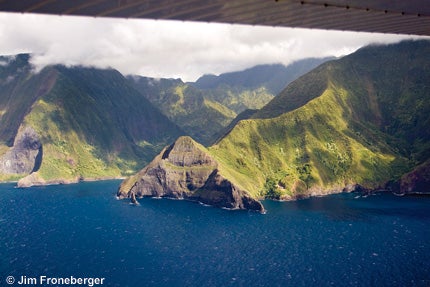 Jurassic Park, then you may remember the scene where Jeff Goldblum describes chaos theory as a mathematical discipline where the results of any given problem are never totally predictable, no matter how carefully conditions are controlled. Chaos theory is sometimes used in predicting weather, which, as every pilot knows, can’t be predicted.
Jurassic Park, then you may remember the scene where Jeff Goldblum describes chaos theory as a mathematical discipline where the results of any given problem are never totally predictable, no matter how carefully conditions are controlled. Chaos theory is sometimes used in predicting weather, which, as every pilot knows, can’t be predicted.
As you might imagine, ferry pilots aren’t allowed to believe in chaos theory. Deluded fools that we are, we have to believe that with the proper amount of preparation, we can solve any problem, overcome any obstacle, survive any emergency.
Sadly, that’s not the case. Statistics indicate that 5% of us die yearly, the highest mortality rate in aviation (higher even than air show pilots), so proper prep may not sidestep every emergency. Still, we have to believe in something.
Accordingly, I’m doing everything possible to guarantee that my upcoming delivery in a Grand Caravan from Long Beach, Calif., to Seoul, Korea—trip number 202—goes without a hitch.
A recent inquiry from a longtime reader wondering what goes into preparation for a ferry flight prompted me to ponder everything that happens before the trip.
I’ll be flying the 7,500 nm from California to Korea in one of GA’s most comfortable planes. The Caravan is a good ride, but it wasn’t designed for speed. It takes considerable winding of the large key on its back to reach a reasonable cruise number. Cessna’s big 208 is a heavy hauler with the stability of a locomotive, the manners of a Skyhawk and the simplicity of a Tonka toy.
Fortunately, N48JA has had the underbelly cargo pod removed, so I won’t be slowed by a huge protuberance beneath the fuselage. Previous trips suggest I’ll see about 150 to 155 knots heavy, 160 to 165 knots light in no-wind conditions (which don’t exist on the Pacific).
Route planning is simple, as there’s only one practical route for us little guys—the same one I’ve flown a dozen times. Yes, you could track north through Anchorage and Kotzebue, Alaska; then, arc back down through Anadyr, Siberia, and Petropavlovsk, Russia, but only if you had a very large supply of money. (Jet fuel is available in Russia, but there’s no avgas. If you need avgas, you must have it shipped in and secured until you arrive.)
The trip devolves to four fairly long legs. The first hop is the longest, Santa Barbara to Honolulu on the Delta track—2,154 nm, or about 14.5 hours in a Caravan. Once I pass the Channel Islands, there’s not even a rock sticking out of the water, so for the first six or seven hours, my only alternate will be a return to KSBA.
Ironically, because the wind nearly always starts off as a headwind and winds up a tailwind, I’ll need to begin the trip with a howgoesit that suggests I won’t make it. According to the University of Hawaii’s Atmospheric Research Department, the wind typically rotates clockwise from west to northeast as you get farther from the mainland. By the time you’re 1,400 nm out of Santa Barbara, U of H suggests you’ll be benefitting from a 10- to 20-knot push about 94% of the time.
I was a victim of the other 6% 15 years ago, delivering a new Mooney MSE from Kerrville, Texas, to Dubbo, Australia. I had been flying with my buddy Jon Egaas in a big yellow turboprop Ayres Thrush crop duster headed for Brisbane. Egaas had diverted to Hilo and flamed out on the ramp after landing. I touched down in Honolulu with about five gallons remaining in the tanks—rather not do that again.
This time, I’ll be flying in October, so weather shouldn’t be a major concern for the first and second legs. In 20 years of flying between the mainland and Honolulu, I’ve rarely seen any major weather at low level. Winds can be a hassle, and I’ve had to delay some departures as long as a month waiting for acceptable winds for the crossing.
After a butt-recovery day in Honolulu, it’ll be on to Majuro, Marshall Islands—1,986 nm distant. With the help of prevailing trade winds, I should make that leg in 13 hours. Again, as with the first leg, there’s little to see in the Central Pacific except water (duh!). Tiny Johnston Island is directly on the route, only 712 miles out, but it’s little more than an abandoned U.S. military base that’s barely larger than the runway it once supported. I’m told recent tsunamis have washed over the island and left few of the Quonset huts standing.
The next morning, I’ll be off early from Majuro, routing over Kwajalein, tracking west, just south of Bikini and Eniwetok, and on to either Guam or Saipan in the Marianas. Total distance is 1,600 nm, probably about 11 hours, a short day in the ferry business. You certainly wouldn’t want to go down on this leg, but at least there are a few places to divert—Kosrae, Pohnpei and Truk—all slightly south of course, plus hundreds of coral atolls on this route, most barely above the waves.
The monsoon season will be in full swing in the western Pacific, so clouds, rain and humidity will be at their peak in the Marianas. Guam receives about 25 inches of rain in October, which is one reason the U.S. military tests all its jungle equipment on the island.
Guam and Saipan lie adjacent to the deepest water in the world, seven miles straight down to the bottom of the Marianas Trench. If that sounds a little unnerving, consider that seven feet of water could be just as deadly.
Finally, the last leg will be due northwest, crossing over the island of Kyushu, Japan, up the Korean Peninsula and on into Seoul, 1,650 nm from Saipan. This region is known as Typhoon Alley, the birthplace of many Pacific storms. Experience suggests consistent headwinds will probably stretch that leg to nearly 13 hours.
Before any of that can happen, however, the airplane will need to undergo an Export Certificate of Airworthiness inspection, similar to an annual, but more thorough in checking serial numbers of components. The airplane will also need a Shipper’s Export Declaration, typically executed by a customs broker, a hard-card registration and a letter from the owner authorizing me to remove it from the U.S.
Once the export requirements are complete, the Caravan will have all seats except the front two removed and shipped, and will be fitted with 400-gallon ferry tanks. That will bring total fuel to 732 gallons (4,904 pounds). With that much fuel aboard, I’ll be herding a five-ton pachyderm across the Pacific, specifically at about 10,400 pounds, 2,400 pounds over gross. Fortunately, hauling a load is what the Cessna 208 does best.
The Caravan metabolizes dead dinosaurs at 42 gph (281 pph), so I’ll have about 17.5 hours’ endurance at high cruise, 19 to 20 hours if I pull back the left lever and fly at best-economy settings. Despite Murphy’s law, which suggests any attempt to stretch fuel is guaranteed to increase headwinds, I should still have at least a three- to four-hour reserve on the longest leg—Santa Barbara to Hawaii. After that, it gets easier, it says here.
Finally, an HF radio will be installed on the right front seat, along with an automatic tuner. The tuner will be connected to a long wire antenna, strung through a storm window to the right wingtip, and then to the top of the tail, long enough to allow the tuner to handle any HF frequency on the South Pacific.
Of course, I’ll be carrying two portable GPS units, a portable VHF COM and new IFR/VFR charts for most of the Central Pacific. I’ll have a four-man raft aboard, along with at least three vests, signal flares, signal mirror, dye marker, emergency rations, water and all the other ocean survival gear just in case.
I’ll also be carrying a Spot Personal Tracker, which will transmit my position via satellite every 10 minutes. Again, however, with any luck at all, the trip will be long over by the time this column sees print. In theory, you’ll have been able to watch my progress across the ocean.
If all goes well, I’ll be able to write the next column after the fact, another exciting account of an uneventful, 50-hour Pacific crossing.



